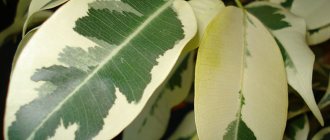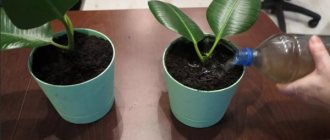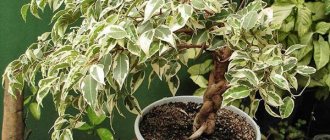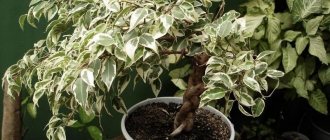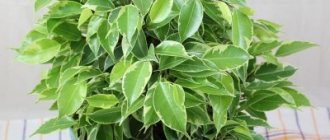How to choose in a store
You can buy ficus Starlight, which is considered one of the most ornamental plants, at any flower shop. When choosing, you should carefully examine the crown to purchase a strong bush.
Its condition can be determined by the following qualities:
- a healthy specimen has fresh leaves, without black, yellow or red spots on the surface;
- shoots are flexible, do not contain breaks, cracks, growths and rot;
- the buds are green and elastic.
When purchasing, shake off the crown; if the leaves do not fall off, the flower is healthy and can be purchased. The average price for a seedling is from 400 to 500 rubles.
Benefits and harms
- A houseplant such as Ficus Benjamin Starlight can be useful in the following ways:
- cleans the air of harmful impurities of formaldehyde, phenol and benzene, saturates it with oxygen;
- serves as an excellent interior decor;
- Watching a beautiful plant promotes calm and relaxation.
- This plant can cause the following harm:
- may be poisonous to small children and animals and should be kept away from them;
- Milky sap on contact can cause allergies, it is especially dangerous for asthmatics.
Description of ficus
Starlight is a variegated plant of the Mulberry family, a variety of Benjamin.
The description includes several distinctive qualities:
- leaves are small, green - 5 cm long, contain whitish spots in a chaotic pattern, some specimens are completely white;
- the edges of the leaf blade are slightly wavy, with a matte surface;
- the branches are flexible, drooping, and tolerate pruning well;
In the wild, the plant is huge - reaches 5 m in height, at home it is no more than 1.2 m, and grows slowly - the annual growth is 5-10 cm. The lifespan of an indoor specimen is 15-20 years.
In addition to decorative qualities, ficus has many other advantages:
- cleans the indoor air of toxic substances, formaldehyde, benzene, phenol, saturates it with oxygen;
- has a beneficial effect on the nervous system - calms and pacifies.
The flower is considered poisonous, especially for animals and children, so it should be kept out of reach. If it comes into contact with the skin, the milky sap may cause an allergic reaction. When caring for it, you must wear rubber gloves.
Characteristics of the variety
The name Starlight is translated into Russian as “starlight”. The variety was obtained from a mutated branch of Ficus Benjamin, which, as a result of a genetic defect, lacked chloroplasts along the edges of the leaves. They are the ones that contain the green pigment.
Are you already growing ficus Starlight?
Yes
75.61%
No
24.39%
The original trait was strengthened and fixed by selection; in fact, all ficuses belonging to the Starlight variety are clones of the same plant. Even those that have a different leaf size or white border width in the photo.
Without pruning, Starlight forms a well-branched, medium-sized tree 100-110 cm high, with an erect crown and quickly hardening gray bark. Annual growth is 5-10 cm, depending on care and maintenance conditions.
In potted culture, the lifespan of Benjamin's ficus is on average 15 years. But there are long-livers. They can reach a size of 2 or 3 meters if growth is not restrained by pruning or other means.
The crown of the Starlight variety is dense, the leaves are elongated oval, with a sharp tip, smooth edge, smooth surface, about 4-6 cm long, cross-section - 1.3-2 cm. The white border is wide, occupies most of the plate, with good lighting in places reaches its middle.
There is a certain similarity with the Twilight and Kinky varieties. But the first ficus has a narrower light stripe and the green areas are darker, while the second is a dwarf form, variegation is indicated only on the edge of the leaf.
Growing conditions
To grow a beautiful and healthy bush at home, the seedling should be provided with all the necessary conditions for growth and development.
Temperature
Optimum temperature in the spring-summer period: during the day 23-25°C, at night it drops to 18-19°C. This difference ensures health and full growth of green mass.
In winter and autumn, lower values are required: up to 16-20°C during the day and 12°C at night.
The flower does not react well to drafts, so when ventilating the room, especially in winter, it must be taken to another room. Otherwise, the leaves on the ficus will turn yellow and fall off.
Importance
Ficus loves high air humidity - 75-80%. To ensure this condition in spring and summer, it is sprayed with warm boiled water every other day.
Additionally, place an open container of water in the room or place the flowerpot on a tray with wet pebbles or expanded clay.
In winter, it is advisable to keep the flower away from heating devices - they significantly dry out the air, which leads to massive shedding of foliage.
Lighting
This plant with variegated foliage needs good and diffused lighting. With a lack of light, its leaves become pale and monochromatic.
It should be placed on the western or southwestern side of the house with the possibility of shading at lunchtime.
The optimal duration of a day is 10 hours. In winter, this condition is ensured by artificial lighting lamps.
Features of care
Despite the fact that Ficus benjamina is classified as an unpretentious plant, caring for this flower at home will still take some time. The recommendations below will help maintain your “pet’s” decent appearance and health.
Watering
Ficus Starlight loves moderate humidity, so the soil in the flower pot should be in this condition. Watering too often can harm the plant in the same way as excessive drying of the soil. Therefore, you should try to observe the measure. It is advisable to leave the water used for irrigation for several days. It is also not recommended to use too cold or hot water. The liquid should be at room temperature.
Important! Excessive soil moisture can lead to root rot, and subsequently to the complete death of the plant. The first sign of waterlogging is the loss of characteristic color by the leaves and their intensive falling off.
How to form a crown
No matter how carefully and correctly the housewife cares for the StarLight ficus, it will still not be possible to achieve a neat appearance of the crown without pruning. To carry out the procedure, you must purchase sharp scissors. Using a tool, remove old and weak branches of the plant. It is also allowed to trim healthy branches that grow in the wrong direction, thereby spoiling the appearance of the crown. If you want the tree to maintain its compact size, you need to cut off the top of each shoot by a third. The best time to carry out a correction procedure is the beginning of spring, when the plant experiences an intensive period of growth.
Important! It is not recommended to prune immediately after taking the flower home or replanting it. This can complicate the adaptation process.
What soil is suitable
Store-bought peat soil is absolutely not suitable for growing ficus Starlight. Its composition does not contain the substances necessary for the healthy growth and development of the flower, and the texture does not contribute to reliable fixation of the root part. The ideal option for replanting is soil consisting of leaf and turf soil, with the addition of peat and sand. This soil is quite loose and nutritious for the StarLight plant, so the ficus will be comfortable in it.
The required soil can be purchased at any flower shop, so if you need to replant, you should not fool yourself by searching for the right types of soil and choosing the right proportion.
Important! Under no circumstances should soil from the garden, flower beds or front gardens be used without clearing it of pests and pathogenic components.
Lighting
Ficus Benjamin Starlight is classified as a light-loving plant. However, it is also important not to overdo it here. The plant needs bright, diffused lighting, but not intense sunlight. If the flower is constantly exposed to direct sunlight, it is necessary to “darken” the lighting. Otherwise, the ficus leaves may get burned. In the warm season, it is allowed to take the flower outside into the fresh air. But again, you should make sure that the plant is not in the sun all day.
Temperature and humidity levels
The optimal temperature regime for Ficus Benjamin is within +18..+24 C. In winter, the permissible minimum is +16..+20 C. On hot days of summer, it is necessary to constantly moisten the leaves by spraying. The hotter it is, the more often the crown is moistened.
Replanting after purchase
The purchased flower should be replanted
The transplant is carried out three weeks after purchase. First, the flower is quarantined to make sure it is completely healthy, then the procedure begins.
Use a container slightly larger than the size of the root system; you can take a plastic or ceramic pot with drainage holes at the bottom.
Stages:
- the plant is spilled with plenty of water to facilitate the process of extracting the roots and to avoid injury to them;
- Usually, replanting is carried out by transferring an earthen clod, then the voids are filled with fresh substrate - a mixture of peat, humus and sand;
- Afterwards, the ficus is watered and placed in a warm place with good lighting.
Transplantation is necessary not only for purchased flowers, but also for home flowers in the following cases:
- if the plant has become cramped in the old container and its roots are visible through the drainage holes;
- due to damage to roots by rot, parasites and fungal infections;
- It is recommended to replant young flowers every year; adults from 5 years of age do not bother - they only replace the surface soil with fresh and more fertile one.
Transplanting a plant
Ficus Starlight is replanted in the spring:
- young trees up to 3 years of age annually;
- adult specimens as the container fills with roots.
The plant will need a regular-shaped pot with bottom holes for the drainage of excess moisture, 20% filled with expanded clay. The soil is slightly acidic or neutral, loose, permeable, moderately fertile. A specialized one for ficus or decorative foliage plants is suitable.
It is recommended to transfer Starlight into a pot with a diameter 2-3 cm larger than the previous one without disturbing the earthen coma. A complete transplant is done only when the entire substrate needs to be replaced, or there are problems with the root.
A long-lived Starlight growing in a tub, or ficus trees intertwined with trunks, are difficult to move to another container. They are usually not replanted, but only the top layer of soil is renewed annually.
Rules of care
Caring for the Starlight ficus is simple and even a novice gardener can do it. If you follow all the rules of agricultural technology, you can grow not only a beautiful plant, but also one that is resistant to diseases and pests.
Watering
To moisten this flower, use settled or filtered water at room temperature. Prefers moderate watering, because from excess moisture the roots quickly begin to rot.
The scheme is as follows: during the growing season - twice a week, in the cold season - every ten days.
Additionally, on the second day after moistening, surface loosening of the soil is carried out to maintain its moisture and breathability properties.
Feeding
As food, they take ready-made mineral and organic fertilizers for ficuses, which are applied alternately every two weeks throughout the entire growing season - from spring to autumn.
Many people use natural fertilizers - in spring and summer they use preparations with a high nitrogen content. This component stimulates the growth of green mass.
Flower growers use several means - an infusion of manure (1:10), chicken droppings (1:20), a solution of wood ash (1:5) or green fertilizer from nettles (a bucket of raw materials is filled with 5 liters of water).
Crown formation
Basic flower care includes regular pruning. Starting from the age of three years, the ficus Starlight undergoes anti-aging pruning and, along with it, the formation of the crown. This is usually done in early spring before the buds begin to bloom.
For cutting, take sharp and sterile scissors, cut off all the branches growing inward, at the wrong angle, broken off, shriveled and damaged by disease.
If desired, you can create a dense spherical shape by pinching out the apical shoot. This will stimulate the growth of lateral processes.
After this procedure, the plant can be sprayed with Epin solution so that it recovers faster.
Formation of ficus Starlight
To make the tree look neat, sanitary trimmings are needed. All broken, dry, diseased branches that thicken the crown are removed.
In the spring, the crown is formed; from the plant you can make:
- bush;
- topiary;
- bonsai;
- standard tree.
Benjamina is a type of ficus ideal for weaving. From the Starlight variety they create:
- braid;
- single or double helix;
- flat or circular fence;
- column with several vertices.
Reproduction
Very easy to transplant
The best method of flower propagation is using stem cuttings. During spring pruning, shoots are cut off from the apical branches. The optimal length of planting material is 12-15 cm. Before planting, they are immersed for an hour in a root formation stimulator - Heteroauxin or Kornevin. Then they are lowered into water so that the buds are on the surface.
For quick rooting, it is worth creating greenhouse conditions - cover with transparent film or half a plastic bottle.
After about 10-14 days, the cuttings will produce roots, after which they can be planted in small pots with a diameter of 10 cm and always with drainage holes. A nutrient substrate made of river sand, peat and turf (1:1:2) is suitable for planting.
Young plantings are shed with warm water and placed in a warm and well-lit place, but with protection from the scorching sun.
The optimal temperature is 25-26°C, humidity is 80%.
Possible problems in cultivation and diseases
Ficus trees can be subject to the following ailments:
- gray rot. The leaf plate is covered with grayish mold. Diseased leaves must be removed manually and the bush treated with a fungicide (Bravo, Acrobat, etc.);
- powdery mildew. A powdery coating appears on the leaf. At the very beginning, you can get by with a soap solution (wipe the leaves), but in advanced cases only fungicides will help;
- root rot. Appears due to overwatering of the plant. The roots are rotting. You can try removing damaged roots, rinsing them in a pink manganese solution and replanting them in fresh soil. In the future, you will have to adjust the watering;
- anthracnose With this disease, the edges of the leaves become ulcerated. Fungicides should be used in treatment.
Drops buds and leaves
There are several reasons for this phenomenon. The main ones are:
- temperature difference. This applies to both warm and cold flows. Drafts are not desirable;
- improper watering. In winter, it is enough to water once a week, and in summer - 1-2 times a day;
- direct sunlight or, conversely, complete shadow. It is better to place a flower pot in a lacy shade;
- pests such as spider mites, aphids, scale insects, mealybugs. It will be necessary to treat the soil and the plant itself with insecticides (actara, actellik);
- lack of microelements. Special fertilizers for ficus plants will help normalize the chemical balance.
The leaves are turning pale
Leaves may turn pale from lack of light - photosynthesis is disrupted. If diseases and pests are excluded, the situation can be corrected by providing sufficient lighting.
The tips of the leaves are drying out
The tips of the leaves dry out:
- when the heating source is close;
- if the root system is damaged during transplantation.
Zircon will help solve the problem. Suitable for watering (4 drops per 1 liter) and for spraying. Regularity: 1 time per week.
The lower leaves fall off
This happens when there is excessive watering in a warm room in winter. Photosynthesis is greatly reduced due to lack of light. The plant is trying to grow, but there is not enough solar energy. To keep the growing point alive, nutrients will be drawn upward. The lower leaves will no longer receive food. They become dark, dry out and fall off. Additional illumination (even with a regular lighting lamp) or lowering the temperature to 15-17 °C will help solve the problem.
Pests
Starlight is quite resistant to pests. But sometimes it is attacked by pests such as:
- scale insect;
- aphid;
- spider mite;
- mealybug.
Aphids can suck all the juices out of a flower in a matter of days.
To avoid damage to the plant, it must be systematically washed with soapy water.
Note! If soapy water gets in, the roots may be damaged. Therefore, the area of soil around the trunk must be covered with film.
Other problems
Ficus responds negatively to drafts. The result is loss of leaves.
Excessive watering can cause root rot. The plant can be saved by cleaning the damaged area and replanting it in fresh soil.
Sometimes nematodes settle on the roots. To get rid of them, the bush is taken out of its pot and completely immersed in a solution of insecticides (for example, aktar). Then it needs to be planted in new soil.
Diseases and pests
- If the rules of maintenance and cultivation are violated, this flower becomes weak and is often damaged by various infections and insects:
- Spider mites envelop leaves, internodes, and buds with cobwebs. It sucks the juices out of them, as a result of which the affected areas turn brown and die. To combat it, acaricides are used - Actellik or Aktaru.
- Shield. It attaches itself to stems and leaves and feeds on their juice. The drug Decis will help to exterminate it - the crown and the soil under it are irrigated twice with an interval of 7 days.
- Aphid. It reproduces at a rapid pace and can destroy the entire tree in a short period of time. Both adults and young individuals love to feast on the juice of young organs. Karbofos or Fundazol will help get rid of it. Severely affected flowers are sprayed 2 times at intervals of a week.
- Nematode. The white worm eats young roots; if detected in a timely manner, the ficus can be saved. It is removed from the pot, all sore spots are cut off, then the roots are washed under running water and dipped in any fungicide for two hours. After drying, transplant into a new container with a sterile substrate.
- Root rot. Typically, such a fungal infection develops due to frequent waterlogging of the soil. At an advanced stage, the plant is disposed of. Weakly affected flowers are removed from the pot, the rotten areas are cut off to healthy tissue, then they are powdered with charcoal and irrigated with a solution of copper sulfate. Replant into a new pot with fresh soil.
- Anthracnose. With this disease, the leaves become covered with brown spots, and later ulcers form at the sites of infection. Treatment is carried out using fungicides.
For prevention, it is worth buying healthy flowers, planting or replanting them in a sterile soil mixture. It is also important to regularly inspect for damage by diseases and pests and promptly remove damaged areas and treat with appropriate medications.
In addition to this, it is necessary to wash the crown twice a month with a soap solution, covering the substrate. This will prevent the invasion of harmful insects.
Trimming
Like any house plant, ficus requires crown formation. In addition to correcting the shape, pruning is aimed at removing dried and damaged branches.
Ficus benjamina - description and care at home
Sometimes there is a need to maintain the compact dimensions of a flower. In this case, the branches are cut to a third of their length, unless the crown is designed by weaving branches.
Pruning is carried out in early spring before the beginning of the growing season. The tools you will need are sharp scissors. It would be useful to treat the cuts with crushed charcoal or cinnamon powder.
Important! Newly purchased, weak or recently transplanted plants should not be pruned.
Errors during cultivation
Many gardeners, especially beginners, make mistakes in caring for and growing plants, which leads to the loss of its decorative properties and death.
- Irrigation system failure. Due to excess moisture, the roots rot, and due to lack of moisture, the above-ground part dries out and the ficus begins to fall. Therefore, you need to water moderately and regularly.
- Do not overuse fertilizers - exceeding the dosage and frequency of their application has a negative impact on health and appearance. Follow all rules and regulations for the use of fertilizers indicated on the package or bottle.
- Keeping it in the dark causes the leaves to turn pale and fall off. This phenomenon is also possible with a lack of light in winter. Provide plants with 10 hours of light with protection from the scorching sun.
- Avoid drafts, as this can lead to wilting and death of the flower.
After moving
A change in the external environment is stressful for any living creature, including plants. Therefore, you should not worry if during the first two weeks, while the adaptation process is taking place, the leaves of the Starlight ficus turn a little yellow or slightly fall off. To make it easier for the plant to get used to new living conditions, it is advisable to immediately place it in the place where it will be for the rest of the time.
Important! StarLight is light-sensitive, so before you bring it from the store, you should choose a bright corner in advance to place the flower. This way you can simplify and speed up the onboarding process.
Some sellers advise immediately upon arriving home to replant the plant from a poor, peat composition, which is usually used to fill flower pots in stores. However, there is no need to rush! A transplant is an additional stress, so it is better to wait with this procedure for the first two weeks. If it was nevertheless decided to carry out a transplant, it is necessary to use a gentle transshipment method. That is, the flower is transplanted into soil rich in useful microelements, slightly clearing the previous soil, and also without violating the integrity of the root ball.
How to distinguish from other varieties
Twilight and Starlight are very similar to each other: they have the same height and crown shape. But they have one difference - the color of the leaves.
The first leaves are the same green, but the whitish tint is contained only at the edges. In addition, this variety does not have completely white leaves, like Starlight.
It is also easy to confuse with the De Gantelle variety: the color of the leaves, the height and shape of the crown are the same.
But this plant has larger leaves than Starlight’s - the size can reach 7-8 cm. In addition, the number of solid green leaves is predominant - about 80% of the total mass.
Ficus Benjamin Starlight: home care, photo, reproduction
Ficus Benjamina is a popular species among indoor plants. One of its most effective varieties is Starlight.
This plant looks very decorative due to the white spots on the foliage, which make it look like a plant covered with snow.
Let's find out what Ficus Benjamin Starlight is, how to properly care for it, whether it needs to be replanted after purchase, what benefit or harm it can bring.
Botanical description of the plant
Ficus Benjamin Starlight is a variegated form. It has white spots scattered all over the leaf. Sometimes there are plates completely painted white. The leaves are small, about 5 cm long, lanceolate, with entire edges. Like all ficuses, Starlight is an unpretentious evergreen plant native to the Asian tropics.
: Ficus Benjamina Starlight
Unlike many other representatives of the genus of ficus of the mulberry family, this species does not grow quickly - it increases by only 5–10 cm annually.
In the natural environment it can grow up to 5 m in height and is considered long-lived. In room conditions, its growth is limited by its container; it lives for decades. When young it looks like a bush.
It has flexible drooping branches and lends itself well to shaping.
Benefits and harms
- A houseplant such as Ficus Benjamin Starlight can be useful in the following ways:
- cleans the air of harmful impurities of formaldehyde, phenol and benzene, saturates it with oxygen;
- serves as an excellent interior decor;
- Watching a beautiful plant promotes calm and relaxation.
- This plant can cause the following harm:
- may be poisonous to small children and animals and should be kept away from them;
- Milky sap on contact can cause allergies, it is especially dangerous for asthmatics.
Adaptation and transplantation after purchase
Freshly purchased ficus is not immediately replanted. The plant is given 2–3 weeks to adapt to the new environment. It is immediately placed in a permanent place, since the ficus does not like unnecessary rearrangements. At first, there should be no other plants nearby, as a beginner will need quarantine.
After all, not all diseases are immediately noticeable upon purchase, and a diseased plant can infect others. The new plant is not watered for the first few days. Watering is done only if the soil is dry. During the adaptation period, take a closer look at the ficus to see if there are any signs of disease or pests, or if the soil dries out too quickly.
If there are no complaints about the soil and the size of the pot, then replanting should be postponed until the optimal time for this (early spring or autumn).
If the soil dries out too quickly, roots are sticking out of the drainage hole, or the plant is signaling root rot, then replanting should not be delayed and only given a few days to adapt. In addition, during transportation they often use a temporary substrate in which the plant cannot live for long.
When replanting, it is best to use ready-made soil from the store for ficus or palm trees.
You need to choose a pot a couple of centimeters larger than the previous one and put a drainage layer of pebbles, expanded clay or broken brick on the bottom.
The plant is watered before planting and after a while is carefully removed from the old pot. The roots are carefully freed from the old substrate and carefully examined. Rotten or dead roots are removed.
Pour some soil into the pot and try on the ficus. If necessary, add more soil or, conversely, remove the excess. Then the ficus is placed in the middle and carefully covered with the remaining soil. If there were rotten roots, then after replanting the soil is watered with the fungicide “Carbendazim”.
It is recommended to replant young plants annually, and older plants once every 3 years. If the plant is large and already occupies too large a container, then you can simply replace the top layer of soil annually with a more fertile one.
Important! Ficus Starlight should be carefully examined before purchasing. The soil should not be too wet or have a bad smell - in this case, it is better to refuse to purchase such a plant.
Necessary microclimate and care in the future
Ficus plants are considered to be not very troublesome plants, but in the absence of proper conditions and care they can die.
Selecting a location
Ficus Starlight is light-loving, so its location should be well lit. Variegated forms always require a lot of light.
In this case, the lighting should be diffused, without direct sunlight - they can cause burns on the leaves. In winter, it is advisable to highlight the plant. There should be no drafts in the habitat of this ficus.
The pot with it should not be turned or moved from place to place. The plant does not like change and may lose its leaves.
Content temperature
The optimal temperature in summer should be +25...+30°C, and in winter - +16...+20°C. It is possible to reduce the air temperature to +10°C. It should be noted that the lower the air temperature, the less the plant needs to be moistened. Drafts and sudden temperature changes should not be allowed.
Air humidity
Ficuses love moist air, so you need to spray them daily using a spray bottle with boiled water. It is especially important to spray the plant in the summer heat and during the cold period, when heating system devices begin to dry the air in the room.
Important! Dry air in cold weather can cause leaves to drop. This phenomenon can also be caused by severe waterlogging of the soil and root rot.
Watering
It is necessary to moisten the soil moderately. Excess or lack of moisture can negatively affect the condition of the plant. For irrigation, take settled water at room temperature. In summer, watering is carried out 2 times every 7 days. In cold weather, reduce to 1 time every 7–10 days.
Feeding
From spring to autumn-winter, fertilizing should be done every half month. Liquid fertilizers of organic and mineral origin should be used, which alternate sequentially.
In spring and summer, when the ficus is actively growing, it is recommended to use fertilizers with a large proportion of nitrogenous fertilizers. During this period, fertilizing with natural fertilizers (infusion of manure, chicken droppings, nettles or ash) will be useful. During the dormant period, the amount of fertilizing is sharply reduced or stopped until the start of a new growing season.
Crown formation
To rejuvenate, a houseplant is pruned to form a crown.
Using sharp scissors, which are pre-disinfected, cut off damaged and old shoots, as well as branches growing in the opposite direction.
To prevent the ficus from growing upward and being small in size, it is cut off at the top by 1/3. The process of pruning and crown formation is carried out in the spring, when the period of active life of the plant begins.
Propagation by stem cuttings
Ficus Starlight is propagated using stem cuttings, which are carefully cut from the top of the shoots. This process is best carried out in the spring, combined with pruning. For faster rooting, cuttings need to be treated with the drug “Kornevin”.
Cut cuttings (length 12–15 cm) are placed in a container with water. For faster rooting, you can create a greenhouse effect, that is, cover the planting material with a plastic bag. The rooting process lasts about 10–14 days. After the cuttings take root, they need to be planted in the soil.
During this period, the temperature should be maintained at +24…+26°C.
The soil for planting is made from a mixture of peat, perlite, soil and sand, but it is easier to buy ready-made. For planting, take pots with a diameter of 10 cm.
Difficulties in growing
Problems with ficus Starlight are associated with improper care, the appearance of certain diseases, as well as pests. It is worth noting that it is rarely affected by the latter.
Often the reasons for leaf fall are dry air, drafts and low temperatures, lack of light, and violation of the watering regime. Excess moisture can lead to fungal diseases.
Let's look at the most common of them:
- Leaf fungus . This disease can be identified by the appearance of dark spots on the leaves. Subsequently, the leaves begin to die. The drug “Fitosporin” should be used.
- Gray rot . It is a gray mold. If you shake the plant, gray dust will rise. Affected areas should be removed and watering reduced.
- Sooty fungus . It appears as a grayish coating on the leaf blades. In this case, the leaves are washed with soapy water, and severely affected ones are removed.
- Root rot . In this case, the ficus gradually disappears, acquiring a nondescript appearance. Unfortunately, if this problem occurs, the plant will most likely have to be disposed of. If not the entire root system is affected, then you can try to revive it - replant it in another soil and remove all the diseased parts.
Ficus can be attacked by the following insect pests:
- Mealybug . It reaches a length of 12 mm, so it can be easily noticed. Stickiness and a white, cotton-like coating appear on the leaves. The leaves become deformed and turn yellow. To eliminate this problem, clean the plant with a soap solution and use the Aktara insecticide. Be sure to replace the soil in the pot.
- Shield . The pest can be identified by the presence of brown plaques and the appearance of a sticky coating on the foliage. In this case, the affected areas should be washed with a soapy solution and then treated with the chemical preparation “Actellik”.
- Spider mite . Identified by white spots and thin cobwebs on the leaves. To combat such a pest, you need to increase the humidity and use the chemical agent “Aktara” or “Sunmite”.
Ficus Benjamina Starlight is a spectacular variegated plant that will decorate any room. He needs to be provided with the right microclimate, and then there will be no problems with him, since caring for him is completely simple.
Source: https://fermer.blog/bok/komnatnye-rasteniya/dekorativno-listvennye/derevya/fikus/vidy-fikusov/fikus-bendzhamina/3368-fikus-bendzhamina-starlajt.html
What does ficus Starlight look like, what family does it belong to?
Ficus Starlight (Latin name ficus starlight) belongs to the Mulberry family. It belongs to the Benjamin species. A distinctive feature of this variety is the marbled color of the foliage.
White spots on the leaf plate look decorative. No other variety has this color. The plant grows slowly. Every year the height increases by 5-10 cm.
The crown can be easily formed of any type, including making it from a bonsai bush.
Ficus Starlight
Briefly about the history of appearance
The homeland of ficus is the forests of tropical Asia. It was from this area that the plant came to European and other countries.
Features of caring for ficus Starlight at home
Caring for ficus Starlight at home is not difficult. This is an unpretentious plant. The main thing is to create optimal conditions in which the plant will feel comfortable.
Features of care in winter, rest period
Ficus Kinki - description and care at home
The dormant period for ficus lasts from late autumn to early spring. At this time, you need to stop feeding the flower and reduce the amount of watering.
When and how does it bloom
Ficus pumila flower - description and care at home
Ficus Benjamin Starlight does not bloom in the usual sense. Orange peas appear on the plant among the green foliage. They can appear all year round.
Possible problems in cultivation and diseases
When growing any indoor plant, problems arise. Most often, the reason lies in improper care or pests.
Drops buds and leaves
Ficus may shed its leaves due to sudden changes in temperature, improper watering or lack of nutrients.
The tips of the leaves are drying out
The ends can dry out due to too dry air and heating. Or the roots were damaged during transplantation.
Ficus varieties with photos and descriptions
Several varieties of this plant have been bred: Natasha, Kinky, Daniel, Mix, Anastasia, Twilight, Lovely.
Ficus Kinki
Ficus Kinki
A variegated variety of ficus benjamina, height 40 centimeters in adulthood. The crown in the first years of life resembles a ball, over time the geometry is lost, the branches grow to the sides, there is no central, pronounced shoot, there are many thin stems. The leaf grows to a size: length – 4 centimeters, width – 2 centimeters. The edge of the leaf of a young plant is pale green, while that of an adult is white.
Ficus Daniel
Ficus Daniel Ficus Daniel
Ficus grows quickly. A competent gardener, with proper care, gains 30 centimeters per season. The plant is covered with flat, dense, dark green leaves. The size of the leaf plate is 8*3.5 cm, the edges are smooth, there is no waviness.
Ficus Anastasia
Ficus Anastasia
Ficus Anastasia grows intensively and is a variegated species. The leaf is 7*3 centimeters, the center of the plate is dark green, the edges and the vein in the center are light green, the surface of the leaf is shiny with a wave.
It is important! All variegated varieties of ficus require good lighting and an optimal air temperature of 23-25 C for their growth.
Ficus Natasha
This type of ficus grows as a bush, the branches are densely spaced, covered with 3*1.5 leaves, the color is uniform, grassy green. The shape of the leaf plate is oval with a sharp end; a depression is visible in its center. The plant grows slowly. Ficus Natasha is used to create bonsai-style compositions.
Ficus Mix
Ficus mix
The plant is tall, reaches 2 meters, has a wide crown, the branches are covered with glossy foliage, dark green, rich in color. Forming a crown by pruning does not harm the plant.
Ficus Twilight
Ficus Twilight Twilight
The plant is tall, up to 1.5 m. The leaves are original white-green in color, drooping down, forming a lush, beautiful crown. The trunk is medium thick.
Ficus Lovely
Ficus Lovely
Variegated, dwarf bush, height of an adult plant 0.5 m, covered with small leaves of variegated color.
Kinds
Ficus benjamina - natural habitat, northern Australia, India, Malaysia. Under natural conditions it grows into a powerful tree; at home, it can reach several meters in height. There are many varieties, with beautifully colored foliage, characterized by smaller sizes. Ficus benjamina is one of the most popular species; in addition to the whitish border on the leaves, it is characterized by thin, shiny, stiffer leaves. Hanging shoots look picturesque.
Ficus benjamina is a species that does not require too much care; it can grow in rooms with dry air due to its leathery leaves. The basis for caring for Ficus Benjamin is lighting; it should not be exposed to direct sunlight. If the room is too dry, the flower will shed its leaves. Do not expose the plant to drafts.
The plant is useful, absorbs chemical pollution in the room.
Ficus dwarf is an interesting species that is a climbing shrub. An original plant with decorative foliage. The variety 'White Sunny' looks especially beautiful with leaves with a white edge. Natural habitats of the species are Japan and China. In its natural habitat, the plant’s stems are several meters long, but at home they are much shorter and are shortened by pruning.
Requires constant, high air humidity and does not like direct sunlight. Ficus dwarf is not demanding to care for at home, given the temperature. Grows well at room temperature and tolerates temperatures below 10 °C.
Ficus binnendii - the species can reach large sizes and is characterized by narrow and long leaves. The plant must be provided with a well-lit place, without direct sunlight. The temperature in summer is approximately 20 °C, in winter it is not lower than 15 °C.
Ficus lyreate is a decorative variety with original and large leaves, the length of the leaves is 40-50 cm. The leaves are green, shiny, leathery, lyre-shaped, wavy at the edges. It grows to large sizes; in natural conditions (West Africa) it is a large tree. At home it requires a lot of space. It is a species that requires a lighted place, without direct sunlight. Air humidity that is too low will result in drying out of the foliage.
Ficus rubber is one of the most popular species grown at home. Characterized by large, shiny leaves, up to 20 cm long. Varieties are more often grown at home. In natural conditions, a large tree. Characterized by rapid growth. Over time, it will require pruning and stimulate the plant to branch.
It is not a demanding species; optimal care should be taken to ensure that the plant is full of strength. Requires a well-lit place, especially variegated varieties, without direct sunlight. For varieties with green foliage, partial shade is more suitable.
Ficus repens is an original species, distinguished by lanceolate leaves and adventitious roots. A flower grown at home does not reach large sizes. Variety 'Variegata' with decorative, variegated leaves.
It is not a species that purifies the air, does not require care, and grows well at room temperature.
Ficus deltoid is a species that does not require care at home. It is characterized by a looser cut, the leaves are not large, obovate. At home, the height can reach approximately 1-1.5 m. The plant looks decorative not only because of the leaves, but because of the greenish fruits, the size of a pea.
Ficus retusa is an interesting tree-like species, more compact than Ficus benjamina. Often grown as a bonsai tree. Requires constant air humidity and grows well at home.
Ficus bengal - a decorative species, in its natural habitat, is a powerful tree. It has decorative, large leaves, oval-shaped, elongated, with noticeable venation.
Useful properties and beliefs associated with ficus
- The phytohormones contained in ficus have a beneficial effect on the reproductive system. That is why those who dream of adding to their family should have this plant in their home. It’s not for nothing that the ficus is called the “family flower.”
- It is believed that a ficus pot placed in the kitchen will bring financial well-being to the owners. And if you place the plant in the bedroom, you can forget about insomnia.
- Ficus is able to absorb the gas emitted by plastics and plastics (formaldehyde). That is why it is simply irreplaceable in offices and enterprises.
- Many esotericists believe that ficus improves the aura in the house. By placing this plant in your apartment, you can protect yourself from anger and envy.
- Ficus Benjamin perfectly purifies the air, filling it with oxygen, ridding the room of numerous bacteria and microorganisms harmful to humans.
- The rubber released by the plant can cause an allergic attack. Therefore, those who suffer from asthma and allergies should not grow such a flower.
- You also need to be careful with the liquid released by the plant. If milky juice gets on exposed skin (especially in children), irritation and even burns may occur.
By caring for your ficus, taking into account all the rules and observing basic precautions, the plant will only bring benefits and will delight you with gorgeous foliage and an original appearance.
Ficus benjamina diseases
This type of ficus is susceptible to diseases, so it is important to recognize them as early as possible in order to begin timely treatment.
Root rot. If the roots of a ficus are rotten, the leaves very quickly begin to turn yellow, then darken and fall off. And the cause of this disease is usually waterlogging of the soil.
Root rot can only be treated in its early stages. You need to remove the affected plant, cut off all the rotten roots, wash the roots in a weak solution of potassium permanganate, dry them, and then plant them in a new pot with fresh soil.
If the damage is severe, the plant cannot be saved. But you can take cuttings from it and try to root them.
Anthracnose. Signs of this fungal disease are brown spots on the leaves. Gradually they grow and become like ulcers. Leaves fall. With severe damage, the plant dies.
The drugs Fitosporin or Alirin are suitable for the treatment of this disease (3).
Cercospora blight. This is also a fungal disease, and its first symptoms appear on the underside of the leaves - these are black spots. A diseased plant's leaves begin to turn yellow and fall off, which can lead to its death.
This disease can be cured with the same drugs that are used to treat anthracnose - Fitosporin and Alirin (3).
Features of cultivation
This variety of ficus, like all its “brothers”, belongs to light-loving plants. At the same time, the sun's rays are strictly contraindicated in this southern culture. Therefore, when choosing a place for it, you should focus on a bright and slightly shaded area in the apartment, where there is a large amount of diffused light.
Some problems when caring for and growing a Benjamin tree, despite its unpretentiousness, sometimes cannot be avoided. But they are all removable:
- The leaves are drying. The tips of the leaves dry out due to lack of light and moisture. This usually happens in winter. To stop this process, extend the plant's daylight hours using artificial lighting and spray it more often.
- The leaves are falling. By dropping leaves, the ficus tree reacts to sudden changes in care: a change of location, a decrease in the air temperature in the room, cold drafts. These phenomena are most characteristically manifested during the changing seasons. For example, when with the arrival of autumn and shortening daylight hours, the plant continues to be watered abundantly, not paying attention to the fact that the soil remains moist between waterings.
- The crown is turning yellow. Shedding individual old yellowed leaves in autumn and spring is a natural process for any plant. But massive yellowing means that ficus care is incorrect. Its main causes are excess moisture and lower temperatures. The soil should not dry out between waterings, but when its top layer is wet, watering is not necessary. If a ficus pot is in a draft (near a balcony door or on a window), even young leaves begin to turn yellow and fall off, and it needs to be rearranged.
- Ficus does not grow in size. The reasons for the decrease in plant growth most likely lie in the disproportionate volume of the pot and lack of sunlight. If the tree does not have enough space, the growth of the crown slows down; if the pot for the ficus is too large, the roots wither. Well. And we have already spoken more than once about the fact that light is the main stimulator of the growth of any plant. The variegated, more delicate varieties are especially sensitive to these shortcomings.
Variegant ficus variety "Starlight"
Ficus benjamina is an amazing, unpretentious, very ornamental plant. It certainly deserves to take its place in your home greenhouse.
Ficus Daniel has the form of a bush. A large number of flexible, densely growing lateral branches extend to the sides from the vertically growing stem. The leaves of the tree have an elongated shape with a pointed end and a glossy surface. The size of an “adult” leaf is about 5 cm. Young leaves are light green in color and darken over time.
Since the homeland of ficus Daniel is the tropical zones of West Africa, Asia and Australia, for the active growth and development of the plant it is important to create conditions close to tropical. Otherwise, the tree will not be able to delight you with juicy, green leaves and an ever-growing crown
Ficus Daniel has the form of a bush. A large number of flexible, densely growing lateral branches extend to the sides from the vertically growing stem. The leaves of the tree have an elongated shape with a pointed end and a glossy surface. The size of an “adult” leaf is about 5 cm. Young leaves are light green in color and darken over time.
Varieties of Ficus Benjamin. Photo
Natasha
– a long-growing species that can be used for bonsai. The leaves are quite small, only up to three centimeters, monochromatic, green, slightly curved.
Kinky
- another dwarf species that most often decorates city apartments. It differs in that the leaves have a pinkish edge, but only in adult plants. The bush is also low, up to forty centimeters. At the beginning it grows compactly, creating a spherical crown, then its branches begin to stretch out to the sides and fall apart.
Daniel
- a variety also with single-colored leaves. They are a very rich green color with a shine, up to eight centimeters. This plant grows well, tolerates pruning, and can easily form a crown.
Mix
- so named rather because in this form plants can have both variegated leaves and monochromatic leaves. The bush is tall, with a well-developed crown. Probably the most capricious of all the Benjamins.
Lovely
– also applies to dwarfs. The height is no more than half a meter. The leaves are elongated, variegated in color, about five centimeters. The crown is lush and lends itself well to shaping.
Starlight
- ficus with the most elegant variegated color. The feathery leaves are decorated at the edges with white and pink spots, and some are very light. This species grows very slowly. The crown forms well with the help of spring pruning and is very unpretentious.
Anastasia
– you can often find this beautiful variegated ficus in large rooms. It grows quite quickly. The leaves are elongated, the edges have a light green edging, and the center of the leaves is the same.
Esther
- a tall bush that constantly requires pruning. The leaves are large, bright green, while the plant is young, they are golden.
Signs and superstitions
Fans of mystical teachings give ficus special properties. It is believed to promote conception. Particular importance is attached to the donor. A flower obtained from a successful married couple in this regard works better.
It is also recommended to keep ficus in the office of any manager. It helps direct your thoughts in the right direction and focus on the main points.
Indoor ficus Starlight is a very spectacular plant. It will be appropriate in both residential premises and offices. In addition, Starlight is also a wonderful air purifier. If you create an optimal maintenance regime, there will be no problems with it.


